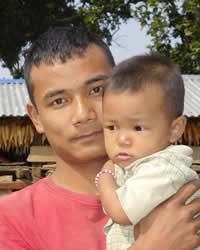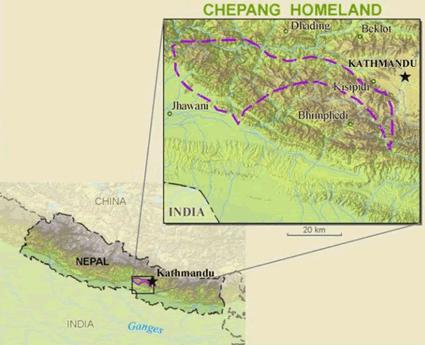Chepang in India

Photo Source:
Copyrighted © 2026
Kerry Olson All rights reserved. Used with permission |

Map Source:
People Group data: Omid. Map geography: UNESCO / GMI. Map Design: Joshua Project
|
| People Name: | Chepang |
| Country: | India |
| 10/40 Window: | Yes |
| Population: | 1,500 |
| World Population: | 72,500 |
| Primary Language: | Nepali |
| Primary Religion: | Hinduism |
| Christian Adherents: | 0.00 % |
| Evangelicals: | 0.00 % |
| Scripture: | Complete Bible |
| Ministry Resources: | Yes |
| Jesus Film: | Yes |
| Audio Recordings: | Yes |
| People Cluster: | South Asia Hindu - other |
| Affinity Bloc: | South Asian Peoples |
| Progress Level: |
|
Introduction / History
The Chepang (or Chewang) are one of the most isolated indigenous groups of Nepal and India. In Nepal they live in the Lesser Himalayan Mountains southwest of Katmandu, the capital of Nepal. A smaller group lives in India near the Nepali border. The altitude of the region where the Chepang reside is between 4,000 to 6,500 feet (1300-2200 meters) above sea level, producing a cool and pleasant climate in the summer and a chilly climate in the winter. The origin of the Chepang is unclear, but there are numerous legends that tell of their relationship to Lav, son of the Hindu god, Rama. Although they are no longer a nomadic tribe, the Chepang still maintain their unique tribal identity.
What Are Their Lives Like?
Destruction of the forests and the demands of an increased population have caused vast land erosion, threatening their environment and their unique culture. Partly for these reasons the Chepang have lived in impoverished conditions. In the 20th century, their quality of life began to improve slightly due to the development of agricultural techniques. Before they began to settle in villages, the Chepang led a hunter-gatherer lifestyle that included some fishing. Today, they live in shacks made of tree branches with thatched roofs. The Chepang cultivate crops such as maize, millet and bananas. They still have customs akin to the nomadic life such as using traps to catch birds and gathering various edible forest products. The Chepang raise a few goats, cows, pigs, chicken, and occasionally a buffalo. For half of the year, they eat relatively well because of their agricultural efforts. However, for the other half of the year, they exist on the products gathered from the forests and remain on the edge of starvation. Some Chepang hire themselves out as laborers in various areas away from their villages and send money home. The Chepang live in rural villages as extended family units, often with three generations living in the same house. If a family has many sons or if a son has many wives, the men will live separately with their wives and children. The family structure is patrilineal (line of descent traced through the males) and predominantly patriarchal (male dominated), but the mother plays an important social role. Marriage among the Chepang is an extremely extravagant affair and more complicated than among other Nepalese hill tribes. When a child is born, the mother is considered polluted; the household must observe cleansing rituals for eight days. On the ninth day, the child is given a name. Twenty-two days after birth, the mother is considered purified and is allowed to resume her participation in any social, religious or community gatherings. The Chepang are without a distinct tribal costume, partly because of their past nomadic traditions. Women wear bangles made of glass and plastic along with various hair ornaments to show their marital status. Chepang society is egalitarian having no class of nobles or any castes. As a tribal people, they are regarded as outcastes or "untouchables" by the large Hindu community. The 2016 earthquake led to worsened conditions and starvation among the Chepang. They are often discriminated against and neglected by governments due to their tribal status.
What Are Their Beliefs?
The Chepang are described as being both Hindus and animists. They celebrate the major Hindu holidays such as Diwali, Holi and Rama's birthday as well as their own holidays. The Chepang have integrated many beliefs and practices from other religions into their own unique system. They perform many rituals and worship a variety of deities. An important ritual the Chepang people observe is known as the Kulain Puja, which involves the worship of dead ancestors. Chepang live in fear of evil spirits which must be appeased by prayers, charms and sacrifices. They believe these spirits will bring them harm if they don't placate them. A small group of Chepang profess to be followers of Jesus Christ. Poverty, lack of literacy and educated church leaders among the Chepang hinders the growth of the church.
What Are Their Needs?
It seems that while some of the Chepang may have heard of Jesus Christ, they still do not have a concept of a single creator God or of sin. Many have never seen a Bible. Most Chepang cannot read or write. Few have access to modern medicine or schools beyond the primary level.
Prayer Points
Pray that God will provide greater freedom to live and work among the Chepang. Ask God to strengthen, encourage and protect the small number of Chepang Christian Believers. Pray that Indian followers of Christ will be led to go to and help the Chepang. Ask the Lord to bring forth a strong Chepang church planting movement for the honor of his name.